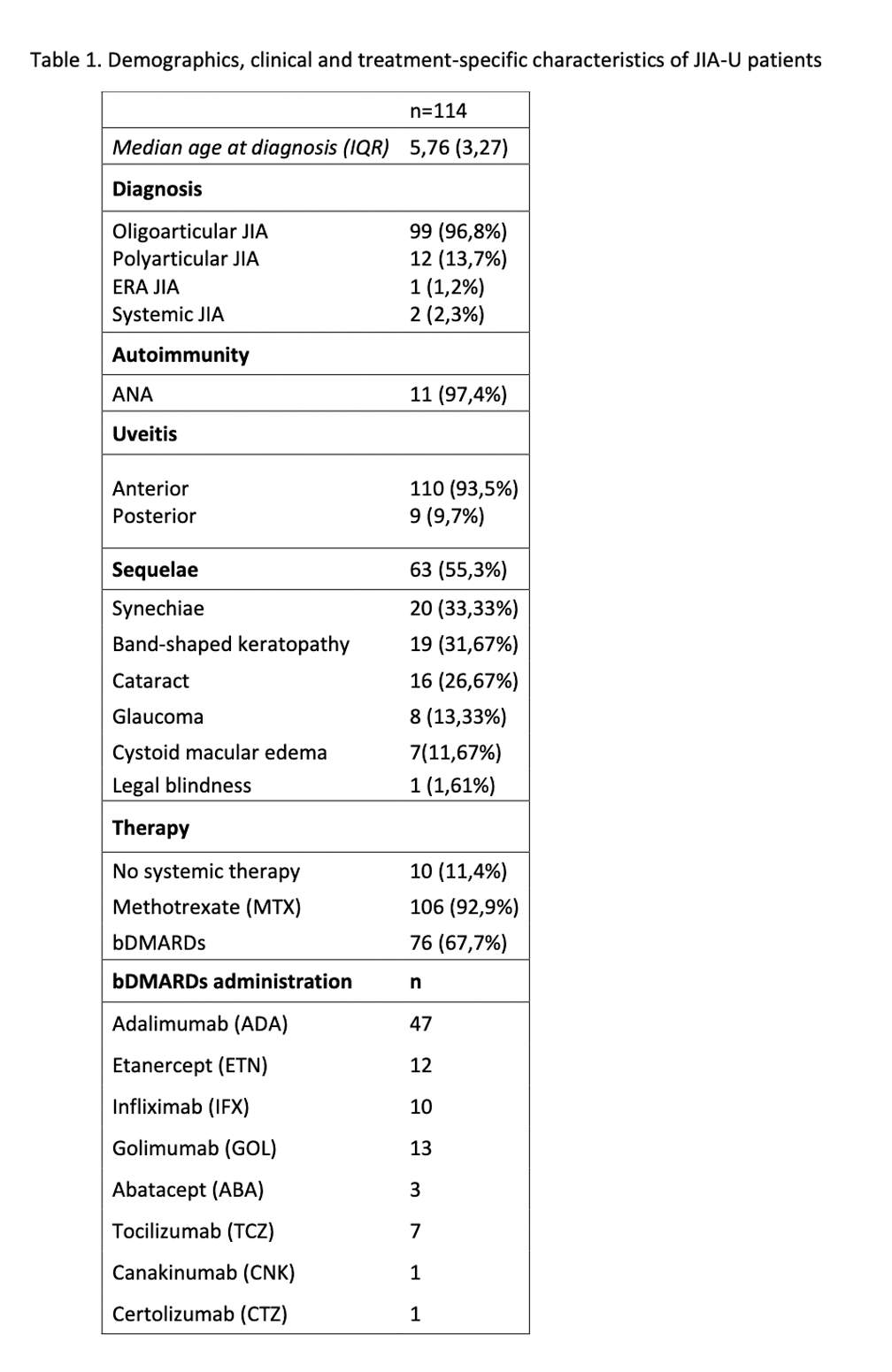

Background: Uveitis is the most common extra-articular manifestation of juvenile idiopathic arthritis (JIA-U), occurring in up to 20% of children with JIA, especially in the mono-oligoarticular ANA+ subset. JIA-U typically presents as asymptomatic, chronic, bilateral anterior uveitis. Up to 38% of patients with JIA-U develop severe visual impairment or blindness, with cystoid macular edema as the most common cause. Chronic inflammation also leads to irreversible ocular complications like cataracts, glaucoma, and maculopathy, affecting the quality of life of these patients since young age. Early identification and aggressive treatment are critical to prevent sequelae in JIA-U.
Objectives: This study aims to investigate the role of methotrexate (MTX) in the management of patients with JIA-U nd whether this can influence the course of ocular disease.
Methods: A retrospective monocentric cohort analysis of JIA-U patients with a follow up of at least 6 months was carried out. Demographics and clinical characteristics were analyzed by standard descriptive statistical methods. Clinical variables and drug treatments were correlated by Spearman’s rank non-parametric test.
Results: 114 patients with JIA-U were analyzed. 89 patients (78%) were female, 99 were ANA positive (87%). The median disease duration was 17.59 years (IQR 13.89). 106 (93%) patients received MTX treatment and 76 (67%) biologic Disease Modified Anti-Rheumatic Drugs (bDMARDs) and/or target synthetic tsDMARDs (Table 1). Of these patients, 28 (25%) were already receiving MTX treatment (onMTX) at the time of uveitis diagnosis. In this group of patients, the presence of complications at onset (p=0.012), long-term complications (p=0.002) and surgical interventions (p=0.015) was significantly lower compared to the group of patients not receiving MTX at the time of diagnosis. Furthermore, the age at onset of uveitis (onMTX 4.7; offMTX 3.7; p=0.02), the number of flares (on MTX 9.6; offMTX 5.4; p=0.007) and surgical interventions (onMTX 0.25; offMTX 0.95; p<0.001) were significantly different between the two groups. In addition, onMTX patients had the most common risk factors for developing uveitis: 84% were female, 28 (100%) ANA+ and 27 (96%) had oligoarticular JIA.
Conclusion: The preliminary data from this study demonstrate that MTX not only delays the onset of uveitis in JIA patients, but also plays a protective role by decreasing the number of disease flares, the development of short and long term sequelae, and the need for surgical referral. These data will need to be confirmed through studies on larger cohorts of patients and an experimental design.
REFERENCES: [1] Ravelli, A.; Martini, A. Juvenile Idiopathic Arthritis. The Lancet 2007, 369 , 767–778, doi:10.1016/S0140-6736(07)60363-8.
[2] Thomas, J.; Kuthyar, S.; Shantha, J.G.; Angeles-Han, S.T.; Yeh, S. Update on Biologic Therapies for Juvenile Idiopathic Arthritis-Associated Uveitis. Ann Eye Sci 2021, 6 , 19–19, doi:10.21037/aes-2019-dmu-10.

Acknowledgements: NIL.
Disclosure of Interests: None declared.